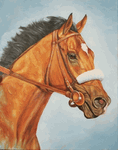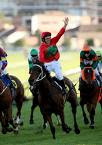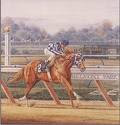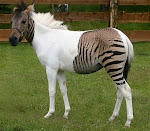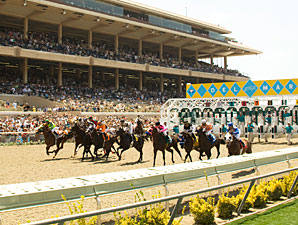
Six horses have died from catastrophic breakdowns at Del Mar during a 10-day span that includes the first week of racing. Three occurred during morning training on Polytrack, two happened during races on Polytrack, and one was in a turf race.
The fatalities came from six different barns. Mad for Plaid, a maiden claimer trained by Peter Miller, fractured her left front sesamoids during training July 19, three days before the meet began. Mi Rey, from the Doug O’Neill barn, suffered a compound fracture of his right front fetlock when he went down in a $10,000 claiming race on opening day. Jockey Rafael Bejarano suffered facial fractures when struck by another horse.
Peanut Ridge, a 2-year-old trained by Chris Hartman, worked a half-mile July 23 on Polytrack in :48.80. The colt, who finished seventh at Lone Star June 12 in his only start for trainer John Tally, injured his right front leg during the work, walked back to his barn, but had to be euthanized the following day.
I Want My Money, trained by Jeff Mullins, broke down in the left front nearing the wire of a starter allowance race July 24. Trainer Mike Mitchell lost Insider when the gelding suffered a compound fracture of his left rear in a starter allowance race on the turf July 26. The sixth incident occurred when $25,000 claimer Maggie and Hopie, trained by Jack Carava, broke down in her left front leg during a work on the main track July 28.
Maggie and Hopie threw exercise rider Jorge Sota. Carava said Sota suffered two broken ribs and a broken vertebra and remains in the hospital. He did not have to undergo surgery, and Carava said the rider is expected to fully recover.
"We came down about a week before the meet started, and everything was fine," said Carava. "I worked about 17 horses before the meet, and it was good. Since the races started, horses haven’t been coming back as good."
Dr. Rick Arthur, the equine medical director for the California Horse Racing Board, said while there are not yet studies to scientifically prove it, breakdowns will often cluster at the beginning of a meet because of a change in racetrack surface. Southern California has three different synthetic main tracks. Del Mar has Polytrack, Santa Anita has Pro-Ride, and Hollywood Park (whose meet closed July 19) has Cushion Track. The Cushion Track this year has been playing more like a traditional dirt surface.
"I hate to be anthropomorphic, but think about if you were jogging on the side of the road and then you started jogging on the sand or the beach," Arthur said. "Apparently, you are putting different stresses on different structures when you change surfaces."
Arthur noted that in 2006, the last year Del Mar had a dirt surface, during the first week of the meet there were five racing fatalities on the main track, one on the turf during a race, and one on the turf during training.
"There were three fatalities on the main track for the entire rest of the meet and one on the turf," Arthur said. "The rest during that time were training fatalities."
Altogether, Del Mar had 18 fatalities during the 2006 meet, one of the factors that led to the CHRB mandate that major California tracks install synthetic surfaces.
"In the 1980s, the HBPA (Horsemen’s Benevolent and Protective Association) funded a survey that had good data," said Arthur. "It showed that the first two weeks of meets were when most fatalities occurred. That was back when the Southern California dirt tracks were very different from each other. The way I interpret the data, horses had to adjust to the new track. That was never confirmed. It is simply a hypothesis."
Del Mar also historically has a high number of horses working on its track daily during the meeting because the off-site stabling is located 100 miles north at either Santa Anita or Hollywood. Over the opening weekend of July 25-26, 195 horses worked on the main track on Saturday and 204 worked over the surface on Sunday.
Craig Fravel, Del Mar’s executive vice president, said Del Mar re-graded its surface since last year. He said they tested the track before the meet to ensure that the Polytrack ingredients, such as the wax, were the same as the previous year.
"We are closely approximating the maintenance procedures we had last year," Fravel said. "We think the track is in fine shape."
This is the third season that Del Mar is racing over Polytrack. In the first year, 2007, some horsemen criticized the surface for being inconsistent from morning to afternoon and suggested that the track needed more water. Times were also slow. The fatality rate during the meet was eight on the main track—two in races and six during training.
For 2008, Del Mar used more water and purified it through a reverse-osmosis process. That appeared to help with the consistency from morning to afternoon, and times were somewhat faster. Eleven fatalities occurred on the main track during the meet—six during races and five during training.
.





